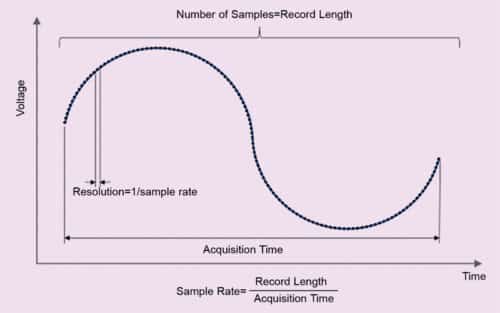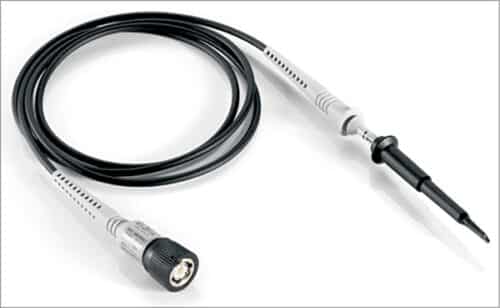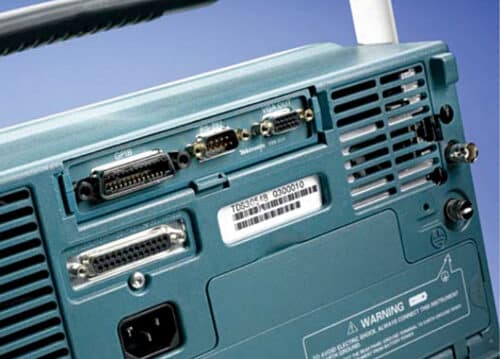An oscilloscope is an indispensable tool for testing and analysis in a wide range of fields and applications. It is an essential instrument for anyone who designs, develops, or fixes electronic equipment. Therefore, it is imperative to be familiar with the ‘scope-jargon’ and be able to select the right one for your application
An oscilloscope, commonly known as a scope, is an instrument that graphically depicts electrical signals and shows how those signals evolve over time. Engineers use them to analyse circuits and assess signal quality. A scope displays the frequency of the signal, whether a broken signal component is causing distortion, how much of the signal is noise, and much more.
For the scope of this article (pun intended), we will go through some crucial parameters that you need to consider while investing in an oscilloscope.
Before looking at the technical specifications of the oscilloscope you are about to buy, you need to know what types of signals you will measure using the oscilloscope—will you frequently work with square waves or sine waves or both? What’s the approximate voltage and frequency range you are hoping to measure? In short, you need to be very clear about how you are going to use the oscilloscope.
End application and type
Depending on your application, you need to choose a scope with a variety of features that work for you, such as bandwidth, storage capacity, sampling rates, portability, maximum memory depth, etc. To get the best performance possible, a proper combination of these features is required. Moreover, certain types of oscilloscopes are better suited for some functions than others. For example, digital storage oscilloscopes (DSOs) can store transient data for later study, analogue oscilloscopes have a larger dynamic range, and digital oscilloscopes offer higher bandwidth.
Most benchtop oscilloscopes are bulky. So, depending on the space restrictions in your lab or place of work, you can even consider some space-saving options like handheld oscilloscopes or those that are computer based.
| Various types of oscilloscopes |
|
• Analogue Oscilloscope
• Digital Oscilloscope • Digital Storage Oscilloscope (DSO) • Digital Phosphor Oscilloscope (DPO) • Mixed-signal Oscilloscope (MSO) • Digital Sampling Oscilloscope • Computer Based Oscilloscope • Handheld Oscilloscope |
Bandwidth
A conventional definition of an oscilloscope’s bandwidth is the highest frequency it can measure without experiencing a considerable amount of distortion from the front-end amplifiers. Most oscilloscope manufacturers specify this at a 3dB level, which is equivalent to a 30% amplitude loss.
The entire oscilloscope, from probes and analogue inputs to CPU and all stages of signal processing, must be constructed to allow for a large bandwidth. This necessitates a significant investment in research and development as well as complex hardware design.
You will get a signal that is muted and warped if you choose an oscilloscope with insufficient bandwidth. Hence, make sure you select one whose bandwidth matches your circuit requirements.
Sample rate and memory depth
The number of samples (the record length) that an oscilloscope can collect each second is known as the sampling rate. The waveform’s resolution is established by this. Because waveforms change quickly with time, you will not be able to see the signal clearly on the oscilloscope screen if its sample rate is too slow.

Nowadays, oscilloscopes have an automatic real-time sampling mode as the default sampling setting. However, most oscilloscopes let you set the sample rate yourself if you do not want the oscilloscope to choose it for you. But be sure to pick a sample rate that will offer sufficient detail to spot any unforeseen signal defects or oddities.
Another important thing to note is that the higher your sample rate is, the higher the memory requirement of your oscilloscope will be. This is because you need adequate memory to store the signal in order to examine and/or analyse it. Therefore, if you want a very fast sampling rate, make sure the oscilloscope has a good memory depth as well.
Instead of utilising the standard byte unit, manufacturers instead use the ‘points’ unit to describe the memory depth of their oscilloscopes. To ensure that the available memory is always filled, current oscilloscopes automatically regulate the sample rate based on the time scale you have selected.
Rise time
An oscilloscope’s capacity to recognise and record quickly rising and decreasing signals is indicated by its rise time. For instance, if the quickest rise time that an oscilloscope can detect is 3 nanoseconds, it means that it has a rise time of 3 nanoseconds. The oscilloscope must be capable of detecting quick changes in order to accurately display the waveform of such a signal.
If you choose an oscilloscope with a slow rise time, and you are working on a circuit that gives square wave outputs, then your waveform may not end up as sharp and square as you want it to be. So, when working with square waves, which have sharp edges, the rise time is especially crucial.
Probes and channels
Typically, oscilloscopes have two or four channels. You can work with more signals simultaneously if your oscilloscope has more channels. But a higher number of channels may lower the sampling rate.
Each channel has a unique connector where a probe can be attached in order to monitor a signal. Only when the probe provides the oscilloscope with the right inputs can it provide accurate measurements. Make sure to choose an oscilloscope that offers all the special probes you need for your application.

Newer parameters
Oscilloscopes have evolved over the years, and it is hard to believe that this technology is over 100 years old! Therefore, it is important to consider some more parameters, especially if you are upgrading your device from a very old version.
Quality of the display
The display of the oscilloscope shows the amplitude (usually voltage) of a signal on the Y-axis and time along the X-axis. Choose an oscilloscope with a range of trace intensity gradations so you may detect small signal irregularities and features in the waveform. The brightness (intensity) of a waveform on a display indicates how frequently a signal appears at that specific location on the display. This means that intensity is an important parameter you should consider. Also, it is simpler to display numerous measurements and locate problematic transient signals on large, high-resolution screens.
Application support
Application software for optical and electrical design troubleshooting and standard compliance is available on advanced scopes. Additionally, oscilloscopes need to include support for debugging embedded systems that use CAN/LIN, PC, SPI, FlexRay, MOST, and other mixed, analogue and digital, parallel and serial technologies. You should be able to easily view signals in the frequency domain as well, especially if you are working on RF circuits. So, make sure the oscilloscope provides you with the necessary application support.
Interfaces and Connectivity
It is always wise to choose an oscilloscope that can be quickly connected to other devices for advanced features and has less complicated interfacing documentation. Furthermore, you should consider an oscilloscope that enables you to connect to a Windows or Linux system for file sharing. Also check if your selected oscilloscope has all the standard interfaces, such as GPIB, USB, RS-232, Ethernet, and LXI.
Powerful analysis
Tools such as zoom, panning, pause, and play are very crucial as they help you focus on what’s important. Moreover, some oscilloscopes have the ‘mark’ feature, which allows you to mark events of importance that you may like to review later. Some models include advanced search capabilities that let you define search criteria to instantly identify every occurrence in an acquisition that does not meet some specified criterion, such as setup and hold time.
| The Rule of 5 |
|
Most vendors recommend the ‘5 Times Rule’ while selecting an oscilloscope:
• The sampling rate of the oscilloscope should be at least five times the highest frequency. • The rise time of the oscilloscope should be five times faster than the fastest signal. • The oscilloscope’s bandwidth should be five times that of the measurement’s fastest signal. |
Remote usage
Remote access to an oscilloscope’s data has become essential as many companies operate in geographically separated locations. Controlling a scope physically from a computer is one approach. Here, a virtual scope front panel provided by a GUI loaded on the PC is used to control the scope, which is connected to the PC through a network. Another approach is saving the waveform data in a file format that may be downloaded from the oscilloscope to a PC where specialised software shows the captured waveform. For example, Tektronix offers the TekScope PC Software for this purpose. Do check if your preferred vendor has such options.
General parameters
Whether you are buying a new phone, car, or any electronic device, there are certain things that are always there on your mind. Is the company reliable? Is the device user-friendly? The same thing is true when it comes to buying oscilloscopes. Here are some general parameters that you should look out for.
Guaranteed specs and good documentation. When selecting an oscilloscope, you should make sure its datasheet lists all the parameters you need to measure as ‘guaranteed specifications.’ The ‘typical’ parameters are merely oscilloscope performance indicators and cannot be used to obtain accurate readings that meet established quality standards.
An oscilloscope’s technical parameters can easily cover many pages. Make sure that your selected oscilloscope’s datasheet has all the important specifications listed without any ambiguity. There are typically a lot of footnotes on the datasheet that describe how a standard was created and/or measured in high-quality scopes. Understanding if the specification is measured and calibrated throughout manufacturing is also crucial, which is why reading the oscilloscope’s documentation is important.
Customer support and forums
Many companies have dedicated support forums for customers to interact with engineers and get their queries about their oscilloscopes answered. You can use these forums also to try and understand which oscilloscope is efficient and easy to use. Talking to customer support executives can also give you an idea and make your selection process easier.

User-friendliness
Oscilloscopes ought to be simple to use, especially for infrequent users. Intuitive controls play a major role here. Users should be able to easily access the most sophisticated functions while still feeling at ease with the scope. The scope should also be responsive enough to quickly respond to changing events.
Many oscilloscopes are also transportable, which enables them to be used outside a lab too! That makes them very user-friendly, as compared to bulky benchtop ones. But this, of course, depends on whether your usage requires portability or not.
Cost
In the end, your selected oscilloscope must not be hard on your pocket. You can buy, lease, or rent oscilloscopes depending on your budget and whether you need them for long-term or short-term use. You can even buy second-hand oscilloscopes.
When purchasing used equipment, consider the instrument’s state and expected lifespan, the functionality provided, and whether the instrument’s proprietary software is compatible with your system. Another smart thing you can do is to look for oscilloscopes that are no longer in production. If these fit your requirements, you can get a really good deal.
Reliability
Future generations of designs must be considered in addition to the current ones. A high-quality scope will provide you with dependable service for many years. It is more likely that you will buy a new car before buying a new oscilloscope!
Comparison of various oscilloscope models
Comparing oscilloscopes and their many parameters is definitely a laborious job. Using the exhaustive comparison chart developed at EFY and published on the Electronics For You website, you can easily leave such tedious tasks behind and focus on what’s important—selecting the right oscilloscope for your application. You can navigate through the chart, sort it based on your preferences, and thus save a lot of time!
To access the chart, please check below.
[wpdatatable id=4 table_view=regular]
The author, Aaryaa Padhyegurjar at EFY, is an industry 4.0 enthusiast with a keen interest in innovation and research.







